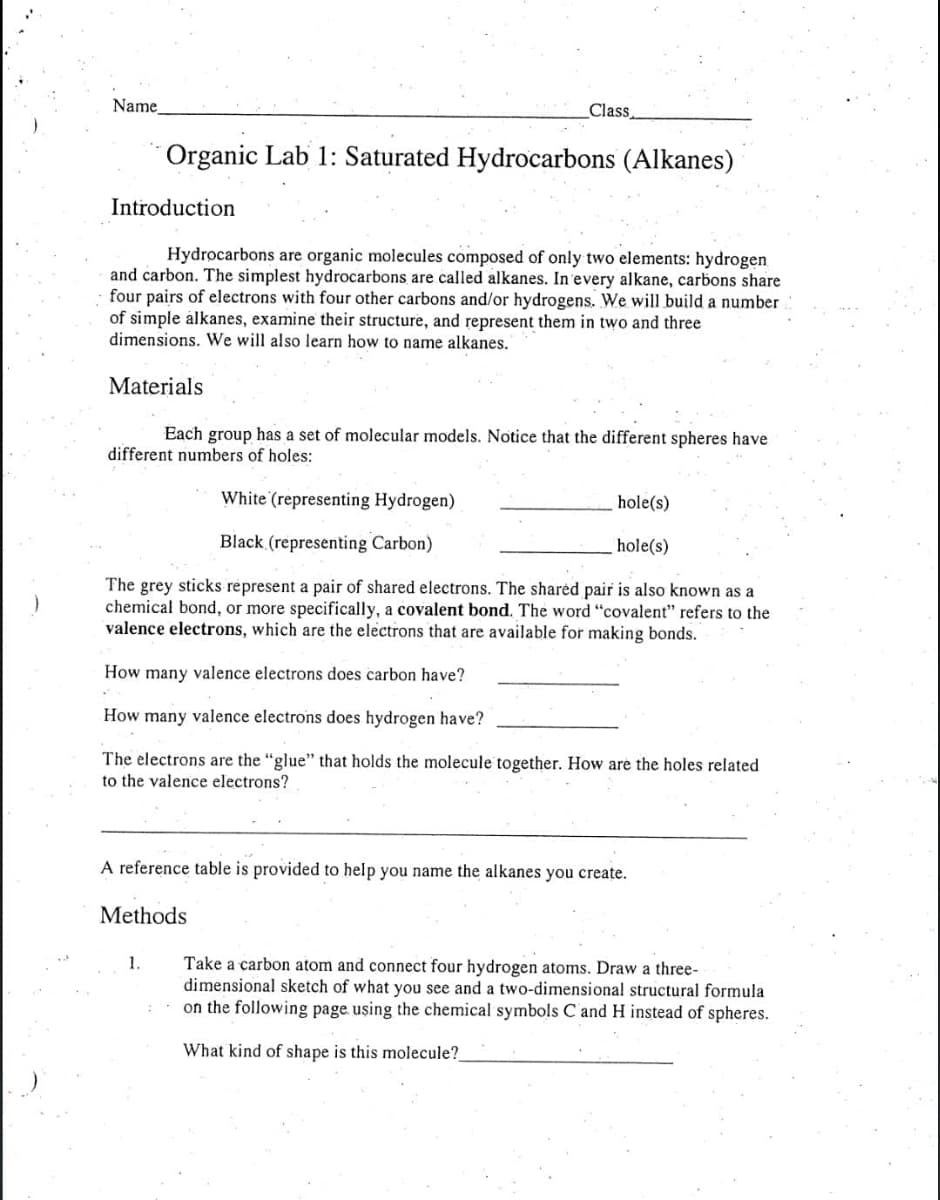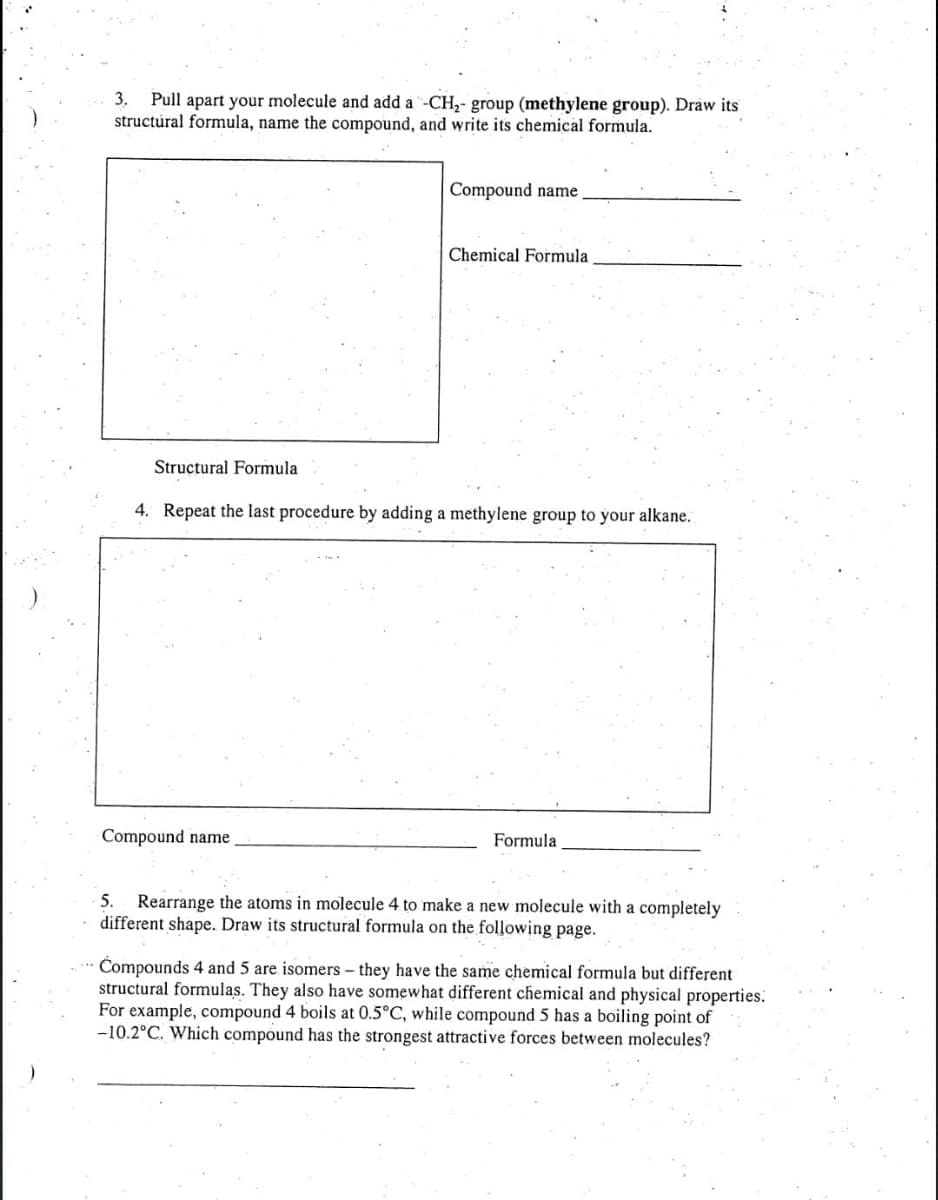Name Class Organic Lab 1: Saturated Hydrocarbons (Alkanes) Introduction Hydrocarbons are organic molecules composed of only two elements: hydrogen and carbon. The simplest hydrocarbons are called alkanes. In every alkane, carbons share four pairs of electrons with four other carbons and/or hydrogens. We will build a number of simple ålkanes, examine their structure, and represent them in two and three dimensions. We will also learn how to name alkanes. Materials Each group has a set of molecular models. Notice that the different spheres have different numbers of holes: White (representing Hydrogen) hole(s) Black (representing Carbon) hole(s) The grey sticks represent a pair of shared electrons. The sharėd pair is also known as a chemical bond, or more specifically, a covalent bond. The word "covalent" refers to the valence electrons, which are the electrons that are available for making bonds. How many valence electrons does carbon have? How many valence electrons does hydrogen have? The electrons are the “glue" that holds the molecule together. How are the holes related to the valence electrons? A reference table is provided to help you name the alkanes you create. Methods 1. Take a carbon atom and connect four hydrogen atoms. Draw a three- dimensional sketch of what you see and a two-dimensional structural formula on the following page using the chemical symbols C and H instead of spheres. What kind of shape is this molecule?
Name Class Organic Lab 1: Saturated Hydrocarbons (Alkanes) Introduction Hydrocarbons are organic molecules composed of only two elements: hydrogen and carbon. The simplest hydrocarbons are called alkanes. In every alkane, carbons share four pairs of electrons with four other carbons and/or hydrogens. We will build a number of simple ålkanes, examine their structure, and represent them in two and three dimensions. We will also learn how to name alkanes. Materials Each group has a set of molecular models. Notice that the different spheres have different numbers of holes: White (representing Hydrogen) hole(s) Black (representing Carbon) hole(s) The grey sticks represent a pair of shared electrons. The sharėd pair is also known as a chemical bond, or more specifically, a covalent bond. The word "covalent" refers to the valence electrons, which are the electrons that are available for making bonds. How many valence electrons does carbon have? How many valence electrons does hydrogen have? The electrons are the “glue" that holds the molecule together. How are the holes related to the valence electrons? A reference table is provided to help you name the alkanes you create. Methods 1. Take a carbon atom and connect four hydrogen atoms. Draw a three- dimensional sketch of what you see and a two-dimensional structural formula on the following page using the chemical symbols C and H instead of spheres. What kind of shape is this molecule?
Chemistry
10th Edition
ISBN:9781305957404
Author:Steven S. Zumdahl, Susan A. Zumdahl, Donald J. DeCoste
Publisher:Steven S. Zumdahl, Susan A. Zumdahl, Donald J. DeCoste
Chapter22: Organic And Biological Molecules
Section: Chapter Questions
Problem 1RQ: What is a hydrocarbon? What is the difference between a saturated hydrocarbon and an unsaturated...
Related questions
Question

Transcribed Image Text:Name
Class
Organic Lab 1: Saturated Hydrocarbons (Alkanes)
Introduction
Hydrocarbons are organic molecules composed of only two elements: hydrogen
and carbon. The simplest hydrocarbons are called alkanes. In'every alkane, carbons share
four pairs of electrons with four other carbons and/or hydrogens. We will build a number
of simple àlkanes, examine their structure, and represent them in two and three
dimensions. We will also learn how to name alkanes."
Materials
Each group has a set of molecular models. Notice that the different spheres have
different numbers of holes:
White (representing Hydrogen)
hole(s)
Black (representing Carbon)
hole(s)
The grey sticks represent a pair of shared electrons. The sharėd pair is also known as a
chemical bond, or more specifically, a covalent bond. The word "covalent" refers to the
valence electrons, which are the electrons that are available for making bonds.
How many valence electrons does carbon have?
How many valence electrons does hydrogen have?
The electrons are the "glue" that holds the molecule together. How are the holes related
to the valence electrons?
A reference table is provided to help you name the alkanes you create.
Methods
1.
Take a carbon atom and connect four hydrogen atoms. Draw a three-
dimensional sketch of what you see and a two-dimensional structural formula
on the following page using the chemical symbols C and H instead of spheres.
What kind of shape is this molecule?

Transcribed Image Text:3.
Pull apart your molecule and add a -CH2- group (methylene group). Draw its
structural formula, name the compound, and write its chemical formula.
Compound name
Chemical Formula
Structural Formula
4. Repeat the last procedure by adding a methylene group to your alkane.
Compound name
Formula
5.
Rearrange the atoms in molecule 4 to make a new molecule with a completely
different shape. Draw its structural formula on the following page.
Compounds 4 and 5 are isomers – they have the same chemical formula but different
structural formulas. They also have somewhat different chemical and physical properties.
For example, compound 4 boils at 0.5°C, while compound 5 has a boiling point of
-10.2°C. Which compound has the strongest attractive forces between molecules?
Expert Solution
This question has been solved!
Explore an expertly crafted, step-by-step solution for a thorough understanding of key concepts.
This is a popular solution!
Trending now
This is a popular solution!
Step by step
Solved in 3 steps with 1 images

Knowledge Booster
Learn more about
Need a deep-dive on the concept behind this application? Look no further. Learn more about this topic, chemistry and related others by exploring similar questions and additional content below.Recommended textbooks for you

Chemistry
Chemistry
ISBN:
9781305957404
Author:
Steven S. Zumdahl, Susan A. Zumdahl, Donald J. DeCoste
Publisher:
Cengage Learning


Chemistry: An Atoms First Approach
Chemistry
ISBN:
9781305079243
Author:
Steven S. Zumdahl, Susan A. Zumdahl
Publisher:
Cengage Learning

Chemistry
Chemistry
ISBN:
9781305957404
Author:
Steven S. Zumdahl, Susan A. Zumdahl, Donald J. DeCoste
Publisher:
Cengage Learning


Chemistry: An Atoms First Approach
Chemistry
ISBN:
9781305079243
Author:
Steven S. Zumdahl, Susan A. Zumdahl
Publisher:
Cengage Learning

Organic Chemistry: A Guided Inquiry
Chemistry
ISBN:
9780618974122
Author:
Andrei Straumanis
Publisher:
Cengage Learning

Introduction to General, Organic and Biochemistry
Chemistry
ISBN:
9781285869759
Author:
Frederick A. Bettelheim, William H. Brown, Mary K. Campbell, Shawn O. Farrell, Omar Torres
Publisher:
Cengage Learning

Introductory Chemistry: A Foundation
Chemistry
ISBN:
9781337399425
Author:
Steven S. Zumdahl, Donald J. DeCoste
Publisher:
Cengage Learning